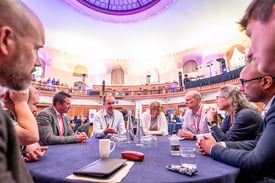Government Data: How to put technology in its place
I had the pleasure of facilitating one of the roundtable discussions at October’s Government Data Summit – a great opportunity to see some familiar faces, while also giving me some insight into the most pressing data challenges these leaders are seeing across government.
 The topic of the roundtable I hosted was ‘Data-Driven Decision-Making’, and it attracted leaders from across departments for a wide-ranging discussion on where this is working really well, while also touching on their goals and their challenges to improve in this space. I was really encouraged to hear participants setting out the ambition of what they were striving to achieve for citizens through harnessing and sharing data, and the desire to tackle challenges in the right way.
The topic of the roundtable I hosted was ‘Data-Driven Decision-Making’, and it attracted leaders from across departments for a wide-ranging discussion on where this is working really well, while also touching on their goals and their challenges to improve in this space. I was really encouraged to hear participants setting out the ambition of what they were striving to achieve for citizens through harnessing and sharing data, and the desire to tackle challenges in the right way.
At the same time, there were delegates who were less clear on the right path to take in tackling their data challenges. They described the pressure they were under to deliver, their budgetary challenges, and the complexity of their legacy estates. In talking about these challenges, people discussed AI, data lakes, digital twins and other technologies that promised to help them deliver.
And as a former civil servant myself, I understand. When problems appear large, complex and scary, it’s tempting to reach for silver bullets which promise to rid you of data challenges; the problem is that technological silver bullets are fictional. We rarely see the promised return on investment.
What’s worse is that those same technological silver bullets can distract you from the fundamentals, and even risk becoming your next data problem to fix. Things like AI can be really interesting to consider in terms of solving business problems and being more data-led, but you have to have the right organisational systems in place to use it well and get value from it.
When problems appear large, complex and scary, it’s tempting to reach for silver bullets; the problem is that technological silver bullets are fictional.
So, what’s the right way to get value out of these cutting-edge technologies? It requires an initial focus on creating and sustaining the human and technical infrastructure that supports and sustains value in your business; and a plan that helps you invest in the right people, processes and skills in the right sequence. You add the cutting-edge technology on top of those foundations to increase value.
Overall, that’s what was so encouraging to me and my Scott Logic colleagues. We met many people at the summit who are interested in how they can upskill their non-specialist staff to make better use of data. Rather than looking for a(nother) one-stop technology solution, they’re interested in wiring together existing sources of data using capabilities available in the cloud. And they’re keen to tackle head-on the challenge of monitoring and governing data and its use across their estate. In other words, they want to lay the right foundations.
This is exactly what we at Scott Logic help government departments to do every day. It’s how we’ve helped the FCDO, it’s how we’re helping ScotGov and HM Land Registry. And it’s how we could help you.





.jpg?width=600&name=image%20(1).jpg)
.jpg?width=600&name=Government%20Transformation%20Show%20-%20podcast%20(22).jpg)